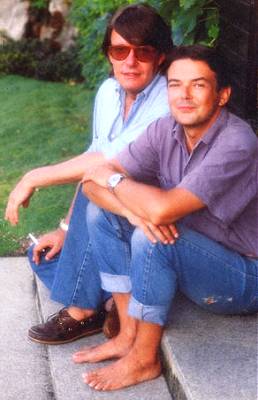| The attempts succeeded splendidly with Fabrizio De
André and Mauro Pagani, who composed and produced
together the album Creuza de mä released in 1984 (3). The
chairman of Ricordi, when notified that the album’s
songs were in the Genoese dialect, forecast sales for a
thousand copies. Since then Creuza de mä has
become one of the best loved and most sold records, not
only by De André but of all Italian popular music.
Musicians such as David Byrne claim it to be among their
favorite, and it is inevitably quoted in World Music
guides in the entry for Italy. But is the dialect of
those songs really Genoese? Mauro Pagani remembers in an
interview that ‘originally it should have been the
record of a traveler, a sailor who returns home after
many years and speaks a language that is a mixture of a
thousand idioms – those that he had encountered in
his wandering. With Fabrizio, the project was thus to
write it in an invented language. What happened later was
that, three quarters of the way into work, Fabrizio had
the ingenious idea to make a record in Genoese (a
language that already contains 1,000/1,200 words of
Arabic origin).’ We cannot trace back Pagani’s
sources or specify whether the words of Arabic origin are
1000 or 1200, or any other (less correct, one can assume)
number. But the Genoese people who still speak their
dialect find that the language in Creuza de mä is
a generous and ingenious artifact, possibly a little less
invented than the lingua franca that would have emerged
from the original project. The music, however, is faithful to the project. For years Mauro Pagani had been interested in what he defines as ‘illegitimate filiations … of ‘Turkish’ culture’ – at least this is how it is indicated in his interview – ‘in contact with autochthonous cultures, in the Slavic countries, in southern Italy as well as in North Africa’. Pagani is not an ethnomusicologist: he is a progressive rock musician (a protagonist in the PFM’s best years) with further experiences also with one of the most creative groups of the Italian folk-revival, Canzoniere del Lazio. His relationship with the ‘autochthonous cultures’ is not philological, and is in great part (although not exclusively) mediated by records. In Creuza de mä his instrumental contribution is as follows: oud, saz, bouzouki, mandolas and mandolins, violin and plectrum viola, a Roland keyboard, flutes and vocals. There is no precise information on how and when Pagani studied each of these instruments, besides the violin and flute that he had already played with great competence in the PFM. However, Pagani still utilizes various bouzoukis in concert, each with a different open tuning that does not correspond to the bouzouki tuning used in Greece
From the musical point of view, then, Creuza de mä does not promise to be more that an honest, autobiographic suggestion of Pagani’s initial idea: a sailor who returns from distant harbors preserving an approximate memory of the sounds that he heard while traveling. But Fabrizio De André’s idea of singing in ‘his’ Genoese, and the mythic expectations of the Italian popular community as regards a Mediterranean music set free from known traditions, triggered the discourse at another level. Creuza de mä thus became, and still remains today in the ideology of Italian popular music, the paradigm of a completely ‘authentic’ Mediterranean, redeemed from both the holographic folklorisms of the past and the pedantry of the philologists. The extent to which this ideological formation adheres to the substance of De André and Pagani’s project is clear. |
